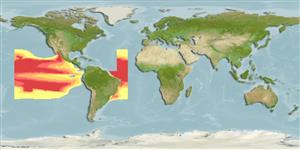分类 / Names
俗名 | 同种异名 | Catalog of Fishes(属, 种) | ITIS | CoL | WoRMS | Cloffa
Elasmobranchii
板鳃亚纲 (鲨鱼与 鱼) (sharks and rays) >
Lamniformes (Mackerel sharks) >
Odontaspididae (Sand tiger sharks)
Etymology: Odontaspis: Etymology not explained, presumably odontos (Gr.), tooth, and aspis (Gr.), shield, perhaps referring to how teeth comprise a prominent narrow cusp provided with two or more small “side teeth” (translation), i.e., cusplets, which, with some imagination, could be said to “shield” the main cusp; another explanation: aspis (L.), viper, perhaps referring to outwardly pointing teeth of O. ferox, like that of a viper (See ETYFish); noronhai: In honor of Adolfo César de Noronha (1873-1963), late director of the Funchal Museum (Madeira), where holotype is housed (See ETYFish).
Eponymy: Adolfo César de Noronha (1873–1963) was a naturalist and librarian who was Director of the Funchal Museum in Madeira (where the type specimen of the shark is housed). [...] (Ref. 128868), visit book page.
Environment: milieu / climate zone / depth range / distribution range
生态学
海洋; 深度上下限 60 - 1000 m (Ref. 10722). 深水域; 31°N - 34°S, 163°W - 27°W (Ref. 54682)
Eastern Atlantic: Madeira and southern Brazil. Eastern Central Pacific: off Hawaii. May eventually be recorded from the Western Central Pacific (Ref. 13568). Questionably occurring in Seychelles.
東大西洋: 馬得拉群島與巴西南部。 中太平洋東部: 外海的夏威夷。 最後可能被記錄從中西太平洋。 (參考文獻 13568) 可懷疑地出現在塞錫爾群島。
Length at first maturity / 大小 / 重量 / 年龄
Maturity: Lm 325.0 range ? - ? cm
Max length : 367 cm TL 雄鱼/尚未辨别雌雄; (Ref. 247); 326.0 cm TL (female)
Snout conical and bulbous, tip rounded. Eyes large and ovoid, nictitating membrane absent. Body color uniform chocolate brown, all fins except pectorals with thin dark edging along posterior margin.
吻锥形而凸起的, 顶端圆的。 眼大的与卵形的, 瞬膜不存在。 体色均匀的褐色又所有的鳍除了胸鳍以外有薄的黑边缘沿着后缘。
A deepwater shark inhabiting the continental and insular slopes (Ref. 50449, 58302). Pelagic (Ref. 58302). Ovoviviparous, embryos feeding on yolk sac and other ova produced by the mother (Ref. 50449). Feeding habits unknown.
一种深水鲨鱼居住于大陆斜坡与岛屿斜坡。 卵胎生的, 胚胎吃产生于母亲的卵黄囊与其他的卵.(参考文献 50449) 进食习惯未知。
Life cycle and mating behavior
成熟度 | 繁殖 | 产卵场 | 卵 | 孕卵数 | 仔鱼
Exhibit ovoviparity (aplacental viviparity), with embryos feeding on other ova produced by the mother (oophagy) after the yolk sac is absorbed (Ref. 50449). Distinct pairing with embrace (Ref. 205).東大西洋: 馬得拉群島與巴西南部。 中太平洋東部: 外海的夏威夷。 最後可能被記錄從中西太平洋。 (參考文獻 13568) 可懷疑地出現在塞錫爾群島。
Compagno, L.J.V., 1984. FAO Species Catalogue. Vol. 4. Sharks of the world. An annotated and illustrated catalogue of shark species known to date. Part 1 - Hexanchiformes to Lamniformes. FAO Fish. Synop. 125(4/1):1-249. Rome, FAO. (Ref. 247)
世界自然保护联盟红皮书 (Ref. 130435: Version 2024-2)
人类利用
渔业: 潜在的兴趣
工具
特别资料
下载 XML
网络资源
Estimates based on models
Preferred temperature (Ref.
123201): 8.6 - 15.2, mean 12 °C (based on 13 cells).
Phylogenetic diversity index (Ref.
82804): PD
50 = 0.8125 [Uniqueness, from 0.5 = low to 2.0 = high].
Bayesian length-weight: a=0.01122 (0.00514 - 0.02450), b=3.04 (2.87 - 3.21), in cm total length, based on all LWR estimates for this body shape (Ref.
93245).
营养阶层 (Ref.
69278): 4.4 ±0.4 se; based on size and trophs of closest relatives
回复力 (Ref.
120179): 非常低的, 最小族群倍增时间超过14 年 (Fec assumed to be <10).
Fishing Vulnerability (Ref.
59153): Very high vulnerability (90 of 100).
